Crawling Back: Amazing Spider-Man #88-90 Review (The Osborn Prelude, Interlude)
Featuring a tragic turn in Spidey's career, these famous issues also push their central villain in darker directions
—by Nathan on August 5, 2024—
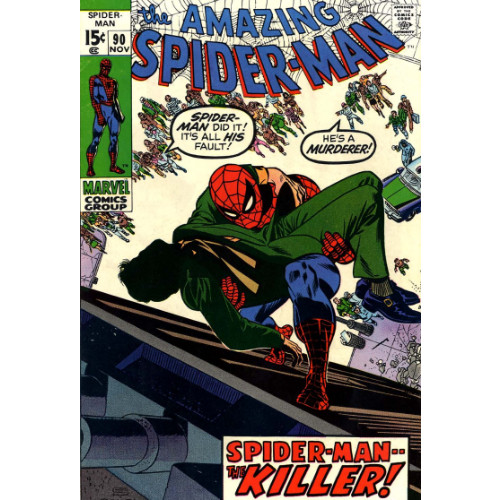
I'm shifting up my publishing schedule again.
When I originally did an "interlude" post early this year, I stated it would be an exception, a brief interruption from my planned "Osborn Prelude" posts. I felt the interruption was warranted, covering the first physical appearance of one Norman Osborn before he unmasked himself before a captive Spider-Man, whose true face was also laid bare.
One of my next "Osborn Prelude" posts will review an incredibly significant turning point in the Spider-Man/Green Goblin saga, and if you are aware of that development, the meaning behind this post should be obvious to you. I won't spell it out in blinding lights, but the issues covered in that post are considered classics for a reason, and not just because writer Gerry Conway penned the first, noteworthy post-Stan Lee chapter in the Spidey/Goblin wars.
As a comics fan, I often find myself curious about context and continuity–sometimes, a story for the sake of a story is enough, but the beauty of comics is that one story can always inform or be informed by another narrative. Knowing the first Avengers issue featuring Captain America involved the team crossing paths with an alien is fun, but knowing Chris Claremont brought that alien's race back during the "Dark Phoenix Saga" creates a connection that previously didn't exist. You see how strands connect these stories together in often unexpected ways. It's one of the joys I find in reading comics and one of the significant reasons why I've devoted blogs to exploring other corners of the Marvel Universe.
So we're taking a slight pause here, setting aside the principal conflict between our red-and-blue hero and his green-and-purple arch-enemy to explore another lauded schism, this one between our red-and-blue hero and a different green-colored combatant. Not the Vulture. Not the Scorpion. Not even Mysterio.
A certain doctor is back in the house…
"The Arms of Doctor Octopus"/"Doc Ock Lives"/"And Death Shall Come"
Writer: Stan Lee
Pencilers: John Romita, Gil Kane
Inker: John Romita
Colorist: Uncredited
Letterers: Sam Rosen
Issue: Amazing Spider-Man #88-90
Issue Publication Date: September-November 1970
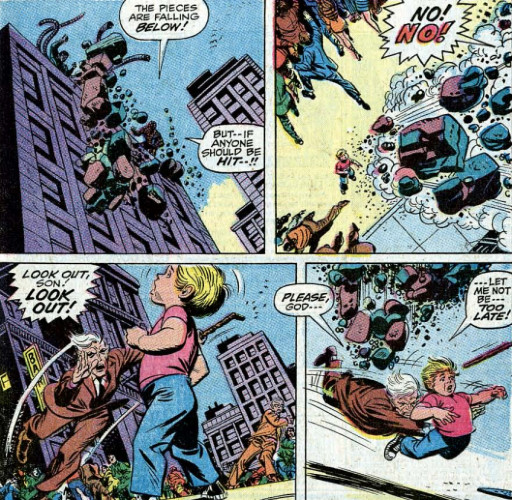
I haven't chronicled the Spidey/Doc Ock conflict the same way I've worked through the whole Spidey/Gobby situation. The devious doctor has popped up on a few occasions, whether in his first appearance, the first formation of the Sinister Six, or even the second and third formations of the same team. But I haven't gone over his every appearance, specifically under Stan Lee. I haven't mentioned the time Spidey temporarily lost his memory and Octavius tried recruiting him as a partner, or the time they fought on a boat and Betty Brant's brother died, or the time they fought under the ocean and Doc Ock nearly succeeded in drowning our Web-Head hero. Maybe I'll devote a "series within a series" someday to their ongoing enmity. I might just have to if I ever want to review the issue where Aunt May almost became "May Reilly-Parker-Octavius"! That’s the best "Worst Doc Ock Story of All Time"!
But we're not there yet. Stan Lee is still the writer of this book, and though he's certainly known for his outlandish plots, it was Gerry Conway who devised the whole "Doc Ock and Aunt May nearly got hitched" idea. For now, Doc is as far from matrimony as possible, beginning this three-issue narrative with the villain remotely controlling his arms (for what has to be the millionth time in a Lee-written Spider-Man book) to assure his escape from prison. What follows is a decidedly dark take on the six-armed scientist-turned-supervillain (cause, yeah, he calls himself "Octopus," but he don't got eight arms) that shows an interesting evolution for the character.
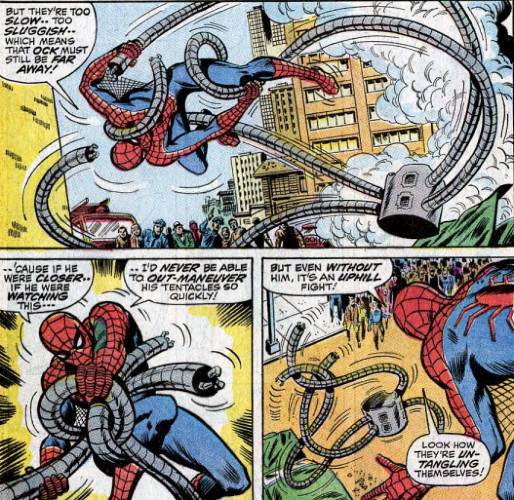
Across the issues reviewed in my previous "Osborn Prelude" posts, you notice an "arc" of sorts for the Green Goblin. Even if the mystery behind his identity weren't an intriguing hook developed in bits across his multiple appearances, the Goblin also sees his motivations get an upgrade: he goes from targeting Spider-Man as a way to impress the criminal underworld he hopes to take over to genuinely despising the Wall-Crawler and wishing for nothing less than his death. Likewise, Octopus is driven across at least two of these issues by his desire to kill Spider-Man (or, in his CCA-approved tirade, his desire to "finally destroy" Spider-Man, for any of those 1970s kiddos worried about the k-word–also, you know this isn't a modern comic because he never mentions hoping to "unalive" Spidey). He nearly blacks out New York in his efforts to draw out our Web-Head; when Spidey appears, he attacks with such ferocity that their titanic, two-issue tussle is worth reading the narrative alone even if this "trilogy" didn't contain a singularly devastating turning point.
Gil Kane delivers page upon page of fantastic fight panels in the middle chapter of this "trilogy." Spidey prevents a water tower from collapsing; he cleverly uses Ock's own arms against him to slam him into a wall; Ock's arms lithely snake around our hero, giving the impression of constant battering and grabbing as Ock fiercely works to rip Spidey asunder. This battle is nothing if not personal. A tense sequence in the third issue sees Spidey hide in an air vent as the tentacles reach and feel for him, calling to mind any horror movie where the protagonist is hiding inches away from a serial killer or monster. And John Romita, though only penciling the first issue, is no slouch either–as Spidey grapples with Ock's arms, he scrambles to hold up a portion of a building which collapses, threatening to crush nearby onlookers. I'm gonna throw in a couple of panels below showcasing some of these sequences–these fights deserve to be remembered for how visually engaging they are.
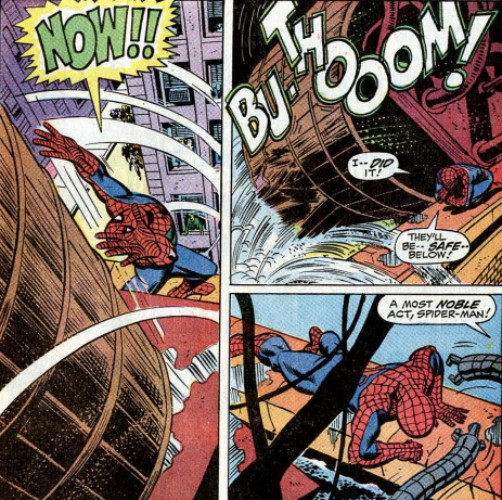
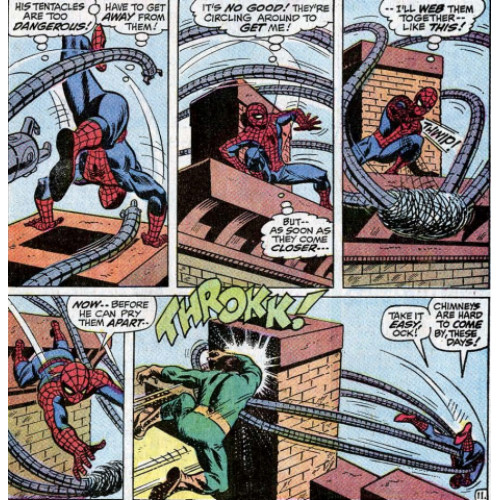
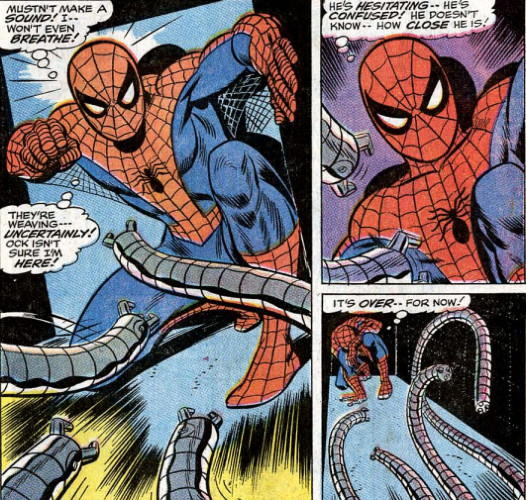
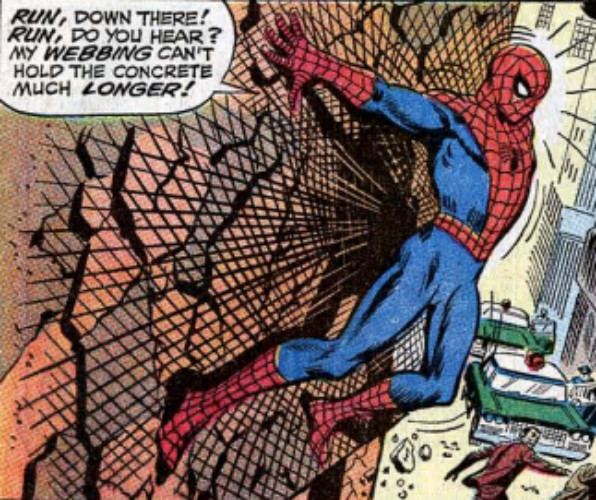
Though this "trilogy" is often remembered for its final issue, Lee and Romita's first installment deserves credit for its portrayal of Octavius. The multi-limbed maniac hijacks a plane, calling to mind several such incidents which occurred during the Cold War. Over a period of six years, 130 U.S. planes experienced hijackings. And Octavius is much less "D.B. Cooper" and more "terrorist material." Lee leverages the fear of a cultural phenomenon well, giving the villain a grim edge few other Spidey foes had achieved at that point. Doc Ock threatens the lives of a whole plane full of people–we've never seen the Sandman or Mysterio make such a stand up until this point. Even the Green Goblin hadn't held more than a few folks hostage at a time. Doc Ock ramps up his threat level considerably by time this first issue ends…and yet the only life he ends up being involved in taking is (mostly) accidental.
So now we turn to the main development of this "trilogy." And though I've been somewhat coy, you can tell from an above image that the final issue of this narrative deals with the death of Captain George Stacy. So let's turn to blunt facts with a dash of speculation: Captain Stacy dies at the hands (and arms) of Doc Ock…and Spider-Man?
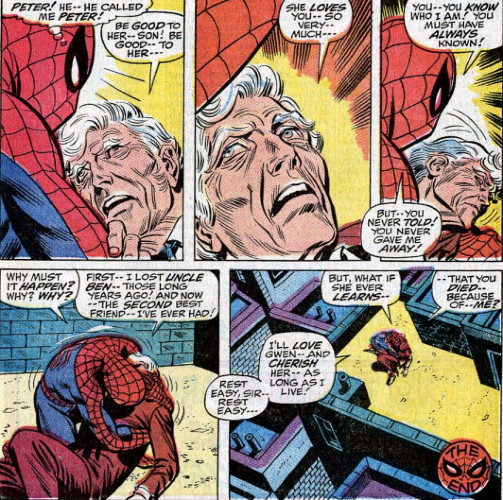
Captain Stacy's death is memorable, a cornerstone event in the life of our hero (a "canon" event, to borrow the language of the most recent Spider-Verse film). George Stacy is not only an ally towards Spider-Man but a close associate of Peter Parker's as well, especially given that Peter is dating his daughter Gwen. His death marks what we may consider the "beginning of the end" of the Peter/Gwen relationship, though that certainly wasn't Lee’s intention. Regardless, his passing sets off a timer, ticking down to a deadly explosion we'll explore in a later post.
Like all good Spider-Man tragedies (if we can call a tragedy "good," though I'm doing so from a purely storytelling perspective), Lee blends in a villain's culpability with Spidey's own eternal sense of guilt. Spidey once let a criminal go free who then murdered his uncle. Spidey once gave his aunt a blood transfusion to save her life only to find out he accidentally irradiated her blood. The guy can never allow himself a break. Here, Spidey invents a kind of webbing which blocks out the signals between Ock's brain and his arms. The arms turn on Octavius, doing the pummeling for Spidey, before lashing out erratically and knocking over a chunk of masonry which plummets towards a small child. George Stacy pushes the child out of the way…only to be crushed himself, dying shortly thereafter in Peter's arms.
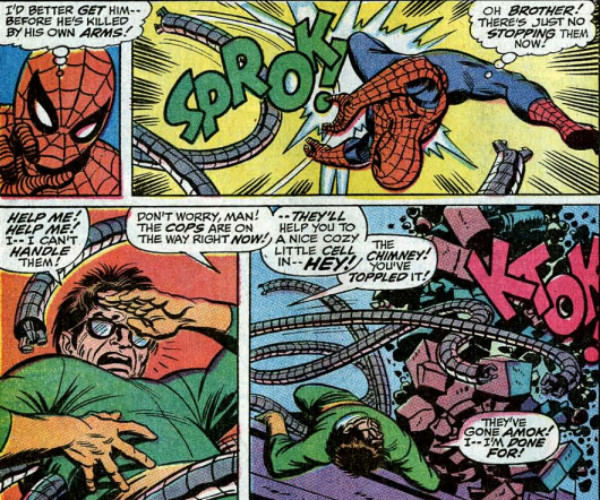
Yes, Spidey could have never predicted his new web-fluid would cause Ock's arms to strike out as they did, and he didn't know George Stacy would be in the area in the exact position to save the life of a child. You can make that argument all you want, and still, Spidey would never allow himself to not feel guilt over his decision. In this instance, more grace should certainly be called for; this isn't like Spidey behaved in his own self-interests and got an innocent person killed as a result. He was doing what he thought he needed to resolve the problem at hand (and hand…and hand…and hand…). But this is Spider-Man we're talking about, the eternal hard luck kid. He's tougher on himself than anyone else is, even when he shouldn't be. That can be a very frustrating facet to being a Spider-Man fan, and here, you sort of wish Peter could make the connection. Simultaneously, the sheer surprise of Captain Stacy's death on the reader probably incites an emotional response which perhaps clouds reason as much as it does for Peter.
This is a running theme for Spidey, even outside Lee's material, that even his best intentions and actions are thwarted, that the sheer decision of being Spider-Man, of trying to make the responsible choice every time, lands him in situations he will always feel guilty about. He's responsible for how he acts, and he feels responsible for the outcomes, and yeah, you can tell him a million times he doesn't need to be, and he's not going to listen. So, no, Spider-Man is not responsible for George Stacy's death, and maybe there's some issue in the Spider-Man mythos where he comes to terms with the old man's passing that I'm unaware of or don't remember. Stacy knows what he's doing when he saves the life of a child. Any other jamoke could've been crossing by and not done anything. Stacy acts. Lee and Kane represent his choice as heroic, sacrificial. And just because Spider-Man isn't killed while stopping Doc Ock doesn't mean he's any less a hero. He saves a plane full of people from a tentacled terrorist. That shouldn't be discredited.
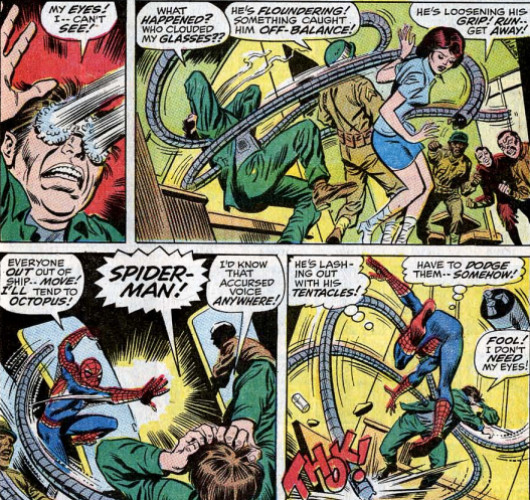
These issues, particularly ASM #90, represent genuine change for our hero. This isn't "illusion of change" stuff Stan Lee often barked about. This is real, permanent. George Stacy is just a guy, and because he's just a guy, he doesn't get to come back like Jean Grey or Wolverine or Bucky Barnes (unless you're talking clones, and I'm saying right now they don't count). As noted, Stacy's death sets off the final phase in the Peter Parker/Gwen Stacy relationship, which we'll unpack more thoroughly a few posts from now. Coming into these issues, I knew about Stacy's death; though I'm certain the moment came as a shock for most readers when ASM #90 was first published, the event is important enough to be reiterated almost as often as Uncle Ben's murder. What I didn't know (or couldn't remember from a previous reading) was how volatile Doc Ock becomes in these issues. I don't recall if he was this nasty or tenacious before, but "taking a plane hostage before attempting to black out New York City" is a new low for the villain. Certainly more vicious than trying to marry an old woman for her inheritance. Brr.